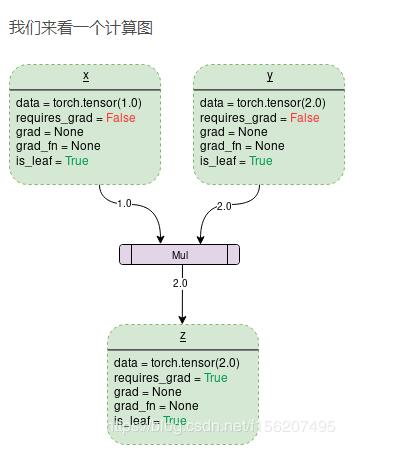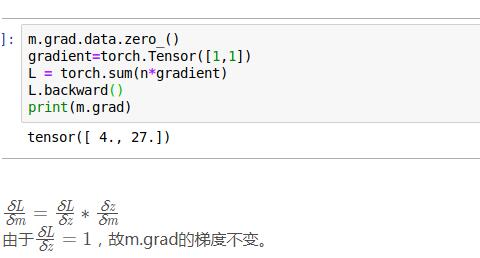基础知识
tensors:
tensor在pytorch里面是一个n维数组。我们可以通过指定参数reuqires_grad=True来建立一个反向传播图,从而能够计算梯度。在pytorch中一般叫做dynamic computation graph(DCG)——即动态计算图。
|
1
2
3
4
5
6
7
8
9
10
11
12
13
14
15
16
17
|
import torchimport numpy as np# 方式一x = torch.randn(2,2, requires_grad=True)# 方式二x = torch.autograd.Variable(torch.Tensor([2,3]), requires_grad=True)#方式三x = torch.tensor([2,3], requires_grad=True, dtype=torch.float64)# 方式四x = np.array([1,2,3] ,dtype=np.float64)x = torch.from_numpy(x)x.requires_grad = True# 或者 x.requires_grad_(True) |
note1:在pytorch中,只有浮点类型的数才有梯度,故在方法四中指定np数组的类型为float类型。为什么torch.Tensor中不需要呢,可以通过以下代码验证
|
1
2
3
4
5
6
7
8
9
10
11
|
import torchimport numpy as npa = torch.Tensor([2,3])print(a.dtype) # torch.floaat32b = torch.tensor([2,3])print(b.dtype) # torch.int64 c = np.array(2,3) print(c.dtype) # int64 |
note2pytorch中tensor与Tensor的区别是什么?这两个看起来如此相似。
首先,torch.Tensor是一个类,所有的tensor都是Tensor的一个实例;而torch.tensor是一个函数。这也说明了为什么使用torch.Tensor()没有问题而torch.tensor()却有问题。
其次,torch.tensor主要是将一个data封装成tensor,并且可以指定requires_grad。
|
1
|
torch.tensor(data,dtype=None,device=None,requires_grad=False) - > Tensor |
最后,我们更多地使用torch.tensor,我们可以通过使用torch.tensor(())来达到与torch.Tensor()同样的效果。
具体可参考torch.tensor与torch.Tensor的区别
Dynamic Computational graph
我们来看一个计算图

我们 来看一个计算图 解释一下各个属性的含义,
data: 变量中存储的值,如x中存储着1,y中存储着2,z中存储着3
requires_grad:该变量有两个值,True 或者 False,如果为True,则加入到反向传播图中参与计算。
grad:该属性存储着相关的梯度值。当requires_grad为False时,该属性为None。即使requires_grad为True,也必须在调用其他节点的backward()之后,该变量的grad才会保存相关的梯度值。否则为None
grad_fn:表示用于计算梯度的函数。
is_leaf:为True或者False,表示该节点是否为叶子节点。
当调用backward函数时,只有requires_grad为true以及is_leaf为true的节点才会被计算梯度,即grad属性才会被赋予值。
梯度计算
examples
运算结果变量的requires_grad取决于输入变量。例如:当变量z的requires_grad属性为True时,为了求得z的梯度,那么变量b的requires_grad就必须为true了,而变量x,y,a的requires_grad属性都为False。
将事先创建的变量,如x、y、z称为创建变量;像a、b这样由其他变量运算得到的称为结果变量。
|
1
2
3
4
5
6
7
8
9
10
11
12
13
14
15
|
from torch.autograd import Variablex = Variable(torch.randn(2,2))y = Variable(torch.randn(2,2))z = Variable(torch.randn(2,2), requires_grad=True)a = x+yb = a+zprint(x.requires_grad, y.requires_grad, z.requires_grad) # False, False, Trueprint(a.requires_grad, b.requires_grad) # False, Trueprint(x.requires_grad) # Trueprint(a.requires_grad) # True |
调用backward()计算梯度
|
1
2
3
4
5
6
7
8
9
10
|
import torch as tfrom torch.autograd import Variable as va = v(t.FloatTensor([2, 3]), requires_grad=True) b = a + 3c = b * b * 3out = c.mean()out.backward(retain_graph=True) # 这里可以不带参数,默认值为‘1',由于下面我们还要求导,故加上retain_graph=True选项print(a.grad) # tensor([15., 18.]) |
backward中的gradient参数使用
a. 最后的结果变量为标量(scalar)
如第二个例子,通过调用out.backward()实现对a的求导,这里默认调用了out.backward(gradient=None)或者指定为out.backward(gradient=torch.Tensor([1.0])
b. 最后的结果变量为向量(vector)
|
1
2
3
4
5
6
7
8
9
|
import torchfrom torch.autograd import Variable as Vm = V(torch.FloatTensor([2, 3]), requires_grad=True) # 注意这里有两层括号,非标量n = V(torch.zeros(2))n[0] = m[0] ** 2n[1] = m[1] ** 3n.backward(gradient=torch.Tensor([1,1]), retain_graph=True)print(m.grad) |
结果为:
|
1
|
tensor([ 4., 27.]) |
如果使用n.backward()的话,那么就会报如下的错:RuntimeError: grad can be implicitly created only for scalar outputs
注意:这里的gradient的维度必须与n的维度相同。其中的原理如下:
在执行z.backward(gradient)的时候,如果z不是一个标量,那么先构造一个标量的值:L = torch.sum(z*gradient),再计算关于L对各个leaf Variable的梯度。

以上这篇pytorch的梯度计算以及backward方法详解就是小编分享给大家的全部内容了,希望能给大家一个参考,也希望大家多多支持服务器之家。
原文链接:https://blog.csdn.net/f156207495/article/details/88727860










